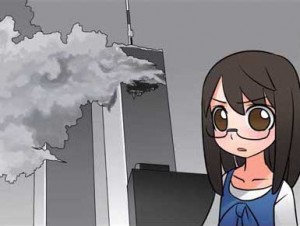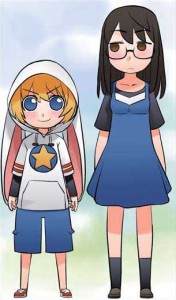Who will bring America’s awesomeness back into English?
by Bob Johnson
Dedicated manga readers seem to both love and hate scanlations. The love comes from having good new manga ready faster than official releases. The hate comes from the inconsistent or kludgy quality. Then depending on the commenter’s sense of self-righteousness, there is the inevitable white knight lecture on copyrights.
Well, I’m sure that the creators of anime and manga never, ever wanted to inspire others to be creative. That’s why there’s no word for doujin in Japanese.
Now, I don’t know a thing about licencing a manga (…yet) , but it seems like most of the titles that get picked up are in the comic book age ghetto, perfect to be shoved into 10,000 retailers in support of the grandma birthday-gifts market. Many of those firms then decide to blow their entire cash savings on ill-timed attempts to turn weeabooism into must unsee TV. Nominally, each is a niche that has some appeal, but you can see how a more sophisticated fan might feel a bit underserved.
Scanlating is hard work – for every chapter of manga they scanlate, fans have put in scores of hours of unpaid tedious translation, layout, and recolouring. And after all this, the scanlation so often just falls by the wayside when there is an “official” release. Then all that work gets lost in the mists of the net, forgotten. Scanlations are awesome because they are made by fans, for fans, for the love of manga and the art itself.
Now before you ask me if I’m trying to take food off your family, what if there was a manga out there without any copyright issues at all? Wouldn’t people just jump at the chance to scanlate that? Wouldn’t the copyright brigades silence their guns? As it turns out, the answer is yes…ish!
Watashi-tachi no Domei — Eizoku-teki Partnership, or “America the Awesome” as I prefer to call it, is a product of the US Forces Japan, which means that, glory of glories, it falls under the public domain as a work of the almighty American military. The wondrous forces of manga fandom managed to produce two translations!
Aaaaaand both promptly lost interest in continuing. One of the efforts gave up after just four pages! Seeing just how much work it is, I don’t blame them for it.
The easy-peasy slice-of-life text bubbles are followed closely by wall-of-text data dumps on military activities with full page art. Scanlating the rest is indeed a daunting challenge, and what’s the cost-benefit there? You can see all the cuteness without translation, after all. What more do you want from your mango?
Oh, plot, you say? Well, you’d best be looking elsewhere! This propaganda is loaded like a JDAM and GPS guided to its demographic target: schoolkids. Best not let something like plot get in the way of telling every 7th grader about America the Awesome.
If you enjoy pie charts telling you about the Pacific Ocean’s greatest love story, Our Alliance is for you. And if you’re the sort who would put 200 hours into putting new squiggles over old, I say get cracking, soldier!
Maybe check it out:
Our Alliance – A Lasting Partnership
Produced by United States Forces Japan
Art by Yukio Hirai, Story by Col. Ayabe


